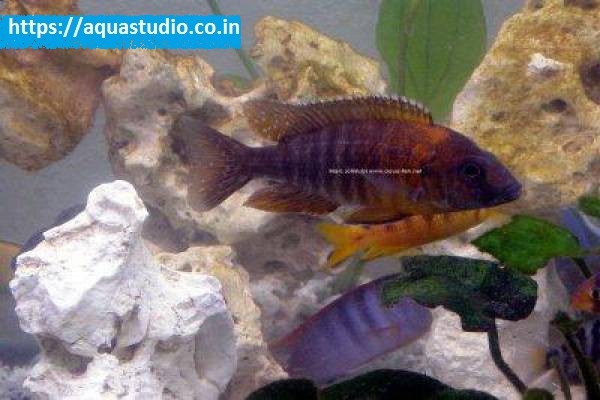Scientific name: Aulonocara maleri Common name: Sunshine peacock Family: Cichlidae Usual size in fish tanks: 8 - 12 cm (3.15 - 4.72 inch) 0 14 Recommended pH range for the species: 7 - 8.5 Recommended water hardness (dGH): 10 - 20°N (178.57 - 357.14ppm) 0°C 32°F 30°C 86°F Recommended temperature: 24 - 27 °C (75.2 - 80.6°F) The way how these fish reproduce: Spawning Where the species comes from: Africa Temperament to its own species: peaceful Temperament toward other fish species: peaceful Usual place in the tank: Middle levels Origin The Sunshine peacock is endemic to the African continent where it can only be found in Lake Malawi. This species inhabits the middle regions of the rocky landscapes and will often venture into the sandy substrate on it’s search for food. Short description The Sunshine peacock belongs to the Aulonocara family and as such displays the aggressive traits associated with this family. The males are highly aggressive and territorial and as such should not be cared for by inexperienced cichlid keepers. These fish display a barred body colouration which comprises of a goldy yellow background colour with vertical bars that are a light brown that run along the whole length of the body. Mature specimens will also display blue markings around the mouth area and along the edging of their dorsal fins. Mature specimens should attain a body length of 8 - 12 cm (3.15 - 4.72 inches) and will require plenty of swimming space in the aquarium. Lifespan If cared for correctly, the Sunshine peacock should have an average lifespan of at least 6 - 10 years of age. General care Due to the active nature of the fish the minimum aquarium size should be at least 4 feet in length and 18 inches in width. They will require open swimming spaces but to create hiding places and territories you will need to add rocks to the rear of the aquarium and offer them a sandy substrate at the front. The Sunshine peacock can withstand quite a wide temperature range of between 24 - 27°C (75.2 - 80.6°F) and the pH should range between 7.5-8.5 Like most of the cichlid species they are high waste produces so a filtration suitably rated for the aquarium should be used and this will need to be backed up with regular weekly water changes of at least 10%. Feeding The Sunshine peacock will spend a lot of time sifting through the substrate looking for food, the substrate is expelled from the gills while the food is ingested. Quality flake or pellet food will suffice for the main diet but this should be supplemented with live or frozen foods such as artemia or blood worms, if feeding with blood worms use these sparingly as overfeeding can cause bloat. For extra vegetable matter you should also add to the diet spirulina flake or chopped peas. Sexing Mature males will be larger than mature females and display a brighter colouration. Breeding The Sunshine peacock is a maternal mouthbrooder so the females will incubate the eggs in their mouth and care for the fry in their mouth until they are large enough to be released into the water column to fend for themselves. It is best to keep the male and females at a ratio of 4 - 1 as a single female will be harassed and become stressed, adding more females shares out the aggressive nature of the male. The male will select a spawning site either on the sandy substrate or a rocky surface and invite the female by displaying to her. When enticed the female will deposit her eggs and take them into her mouth. The male will display egg spots near his anal fin which fools the female into swimming there to gain more eggs but this is when the male will deposit his milt for fertilisation. It can take up to 4 weeks for the eggs to incubate and the fry to be large enough to be released by the female, during this time any stress may cause the female to spit out the brood too early so she needs to remain calm at all times. When the fry are released they can be fed on newly hatched brine shrimp until they are large enough to accept larger foods that the adult fish feed on. Picture Thanks to Marc Janin for picture.
